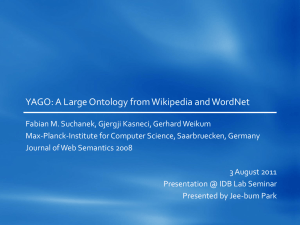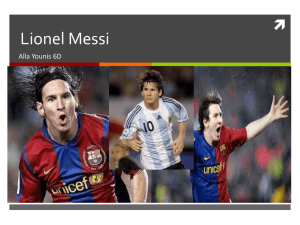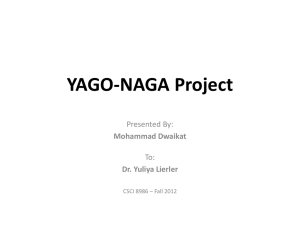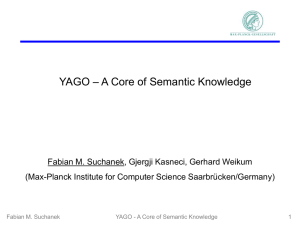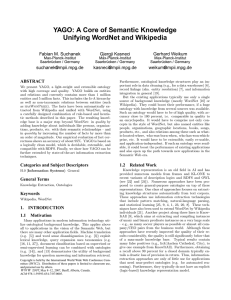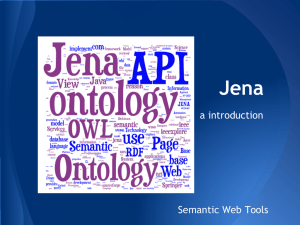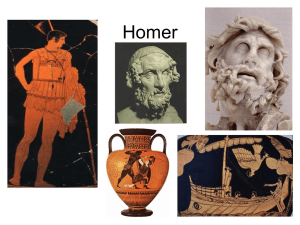Project Presentation
advertisement
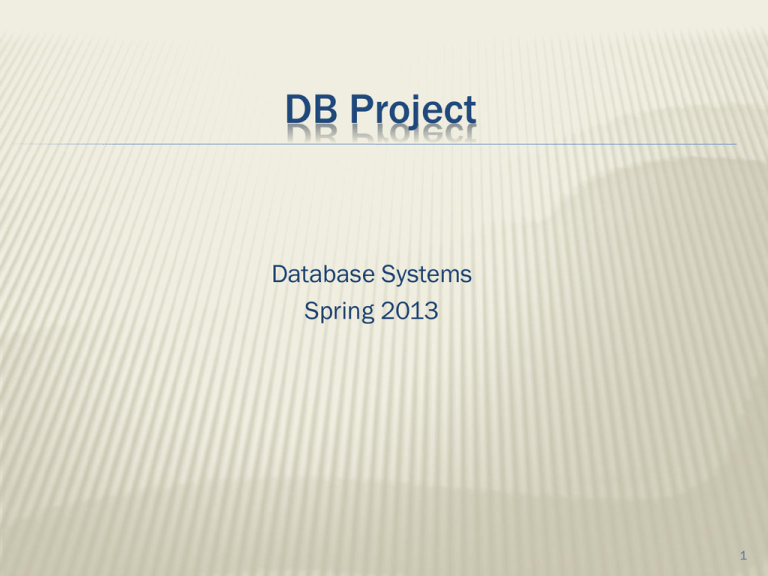
DB Project Database Systems Spring 2013 1 Database project – YAGO Yet Another Great Ontology 2 About YAGO* A huge semantic knowledge base knowledge base – a special kind of DB for knowledge management (e.g., facts) Semantic – related to the Semantic Web where presentation is assigned a meaning http://www.youtube.com/watch?v=TJfrNo3ZDU&feature=player_embedded * Fabian M. Suchanek, Gjergji Kasneci and Gerhard Weikum, YAGO - A Core of Semantic Knowledge, WWW ‘07 3 YAGO is an Ontology A Taxonomy of concept classes At the bottom – instances, facts about instances This is typically the interesting part 4 A fact A particular relationship that holds between two instances hasChild Or, an instance and a literal (string) isPreferredMeaningOf “Martin Sheen” 5 Graph of facts 6 More about YAGO More than 10 million entities More than 120 million facts High (but not perfect!) accuracy Connections with other ontologies (DBPedia, SUMO, Freebase…) Over 11 research papers (Max Planck team) with over 1k citations 7 Database Project - Goals Project goal: to tackle and resolve real-life DB related development issues Including DB design Query writing DB programming Application design Database Project - Requirements 1. Think of an application 2. Design a DB schema 3. 4. 5. According to available data And the application usage And principles of DB design Load and flatten data from YAGO Update the Database Write an application (with UI) 6. Useful and creative! Usable and fault tolerant Accessing the data via efficient queries/updates According to principles of coding Support manual updates and updates from YAGO 9 1. Think of an application Could be anything! As far as your imagination goes YOU should want to use it… Tip: first inspect the available data Tip: must-have and nice-to-have features The application can be interesting even if the UI is simple 10 2. Design a DB Schema Tables, indexes, keys and foreign keys Avoid redundant information Allow efficient queries The script for generating the schema should be submitted with the project More about design in the following lectures 11 2. Creating the SQL Script http://dev.mysql.com/doc/workbench/en/wb-manage-serverexport-to-disk.html 12 3. Load data from YAGO The entire database of YAGO is freely available online Extract relevant parts (entities, facts) Insert into flat tables A few facts may be used for one record E.g., the actor record for Martin Sheen will include his first and last name, birth date, residence, etc. (But not the films he did… why?) We discuss this in detail next 13 4. Update the DB The data should be written to the DB Before submission you will update your schema in the school MySQL server Including relevant IDs Actor_id, film_id,… (Must be integers in MySQL!) Auto-incremental or based on YAGO ids 14 5. Write an application In java, using JDBC Desktop application SWT for GUI (other open-source packages such as Swing, Qt Jambi…) Any other open-source packages, except hibernate and similar packages According to DB programming principles Important: separate the code of the UI, the core logic and the DB 15 5. Write an application (cont.) Using the DB data Efficient queries / updates Important for user experience Use indexes! Interesting queries / updates Search for specific data According to your application 16 5. Write an application (cont.) Should be usable and easy to understand Should be fault tolerant Every exception should be caught, and a user-friendly message should be displayed Test your application Install on different environments Portable: Copy-paste, create DB schema, edit configuration and… play! 17 6. Support updates A must-have feature! “Import” from YAGO Via the UI To support, e.g., a new YAGO version What happens to the “old” data? Administrator privileges? Manual updates Add, edit and delete data originally taken from YAGO Add, edit and delete user-provided data 18 In the course Website Project details Project examination form and grade guide http://courses.cs.tau.ac.il/databases/databases 201213b/assignments/ 19 What to focus on Database structure Data – you choose what to take from YAGO Query efficiency Editing capabilities Usability and fault tolerance 20 YAGO data – HowTo YAGO downloads page - http://www.mpiinf.mpg.de/yago-naga/yago/downloads.html 21 YAGO data – HowTo (cont.) Data comes in TSV format – text with tab-separated fields (also TTL) Format: yago-id entity relation entity <id_zik11d_88c_ehg9uq> <id_zik11d_88c_w3c6wm> <id_1bsrlah_88c_1s6g79w> <id_3ienox_88c_4retae> <id_3ienox_88c_1rk49a2> <id_3ienox_88c_s57m6o> rdf:type rdf:type rdf:type rdf:type rdf:type rdf:type <wikicategory_Vowel_letters> <wikicategory_ISO_basic_Latin_letters> <wikicategory_States_of_the_United_States> <wikicategory_People_of_the_Trojan_War> <wikicategory_Pederastic_heroes_and_deities> <wikicategory_Kings_of_the_Myrmidons> YAGO entities and relations are marked by < > (e.g., <Achilles>) Others are taken from rdf, rdfs, owl, skos… (e.g., rdf:type) Literals are marked by " " <A> <A> <Alabama> <Achilles> <Achilles> <Achilles> Strings with optional locale, e.g., "Big tent"@eng Others with datatype, e.g., "1977-08-16"^^xsd:date, "70"^<m> See also: http://www.mpi-inf.mpg.de/yago-naga/yago/faq.html 22 YAGO data – HowTo (cont.) You can also download just the portions of YAGO2s that you need. Each portion is called a theme. There are 8 groups of themes: TAXONOMY: All types of entitites, and the class structure of YAGO2s. Moreover, it has formal definitions of YAGO relations. SIMPLETAX: An alternative, simpler taxonomy of YAGO. CORE: Core facts of YAGO2s, such as the facts between entities, the facts containing literals,i.e., numbers, dates, strings, etc. GEONAMES: Geographical entities, classes taken from GeoNames. META: Temporally and spatially scoped facts together with statistics and extraction sources about the facts. MULTILINGUAL: The multilingual names for entities. LINK: The connection of YAGO2s to Wordnet, DBPedia, etc. OTHER: Miscellaneous features of YAGO2s, such as Wikipedia inoutlinks, GeoNames data etc. 23 YAGO data – Taxonomy yagoTypes – facts with relation rdf:type - contains the lowestlevel classes for each entity yagoTransitiveType – also contains the higher-level classes <id_zik11d_88c_ehg9uq> <id_zik11d_88c_w3c6wm> <id_1bsrlah_88c_1s6g79w> <id_3ienox_88c_4retae> <id_3ienox_88c_1rk49a2> <id_3ienox_88c_s57m6o> <A> <A> <Alabama> <Achilles> <Achilles> <Achilles> rdf:type rdf:type rdf:type rdf:type rdf:type rdf:type <wikicategory_Vowel_letters> <wikicategory_ISO_basic_Latin_letters> <wikicategory_States_of_the_United_States> <wikicategory_People_of_the_Trojan_War> <wikicategory_Pederastic_heroes_and_deities> <wikicategory_Kings_of_the_Myrmidons> 24 YAGO data - Core yagoFacts – facts between instances A complete list of relations – in Taxomony, yagoSchema <Martin_Sheen> <hasChild> <Charlie_Sheen> YagoLabels – names of entities. There may be many labels! use skos:prefLabel <Martin_Sheen> skos:prefLabel "Martin Sheen"@eng yagoLiteralFacts –other facts with literals Often properties of the entity <Martin_Sheen> <wasBornOnDate> "1940-08-03"^^xsd:date 25 Example Assume we work with the sports domain Create an online application that contains details on teams and players Users/automatic algorithms will guess game scores, awards, etc. 26 Example Editing capabilities for YAGO data: add/remove/edit all players, teams, games… Data of your own: odds, bets… Your tables: Players, Teams, Users, Bets Linking tables: Player_team, User_bets 27 YAGO data – putting it together We want to create records in the table Player(ID, name, birth date, height) First, we look in yagoTransitiveType for entities that represent players We find, e.g., <Lionel_Messi> rdf:type <wordnet_player_110439851> Fixed application parameter 28 YAGO data – putting it together Next, we create the properties ID – e.g., automatically generated (must make sure we do not have Messi in our DB yet!) Name – from yagoLabels <Lionel_Messi> skos:prefLabel Birthdate <Lionel_Messi> <Lionel_Messi> "Lionel Messi"@eng and height – from yagoLiteralFacts <hasHeight> <wasBornOnDate> "1.69"^^<m> "1987-06-24"^^xsd:date 29 YAGO data – Flattening process 1. 2. 3. 4. Read the relevant TSV files Save only the relevant data in memory or in a temporary table Join together relevant pieces of data Insert into the (final) schema tables 30 YAGO data – challenges What do we do when a value is missing? What do we do when the data in invalid? What do we do when there is more than one value? <Lionel_Messi> <Lionel_Messi> <Lionel_Messi> <Lionel_Messi> <Lionel_Messi> <playsFor> <playsFor> <playsFor> <playsFor> <playsFor> <FC_Barcelona_B> <FC_Barcelona_C> <Newell's_Old_Boys> <Argentina_national_football_team> <FC_Barcelona> 31 Relaxations You do not have to fix errors in YAGO’s data (but you can allow the application users to do so) You can choose an arbitrary value if there are many (where this makes sense! playsFor can be many-to-one, actedIn cannot) You can use an additional data source to complete missing data (must be freely available) 32 Past years projects 33 Past years projects 34 Past years projects 35 Past years projects 36 Past years projects 37 Tips First: - understand the data format. - understand what you want to do. - find relevant data and relations. Be flexible: work with what you have! Database key should always be an INTEGER. Don’t forget to support manual edit of the data (add/update/remove) – e.g., artists/categories/values… Configuration – for DB connection, OS, etc. Database Project - Bureaucracy Hard work, but a practical experience. Work in groups of 4 Submission database is MySQL in TAU Java, SWT (or Swing/AWT) Thinking out of the box will be rewarded Database Project - Requirements (at least) 150K records table But could be much more! Also see the course website for full instructions http://courses.cs.tau.ac.il/databases/databases201213b /assignments/ Time schedule April 9th – Project distribution April 18th – Last date for submitting the team member names May 21st – “Project days” I will meet with each group You need to prepare: DB design, preferably have data in the school DB, work plan – what is left to do, who does what and when, optional – presentation or demonstration June 18th – Project due! Aim to submit a week before, to avoid network crushes, mysterious illnesses… 41 DB Project !בהצלחה 42

